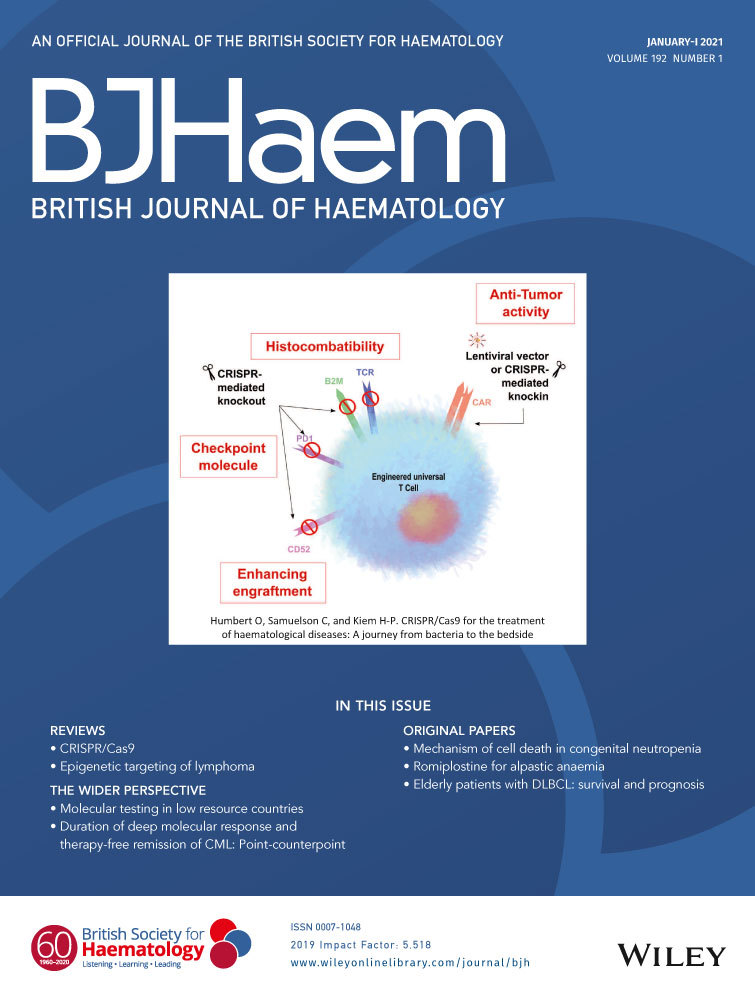Antiviral prophylaxis for hepatitis B carriers affected by diffuse large B cell lymphoma: a matter of survival
Hepatitis B virus (HBV) is a hepatotropic double-stranded DNA virus which can cause hepatitis and cirrhosis; the World Health Organisation (WHO) estimates around 250 million people to be affected worldwide. It is highly endemic in the Western Pacific area and Southeast Asia and Africa, while the prevalence in the United States and Europe is lower.1
The virus is also considered oncogenic and is associated with an increased risk of cancers such as hepatocellular carcinoma and biliary cancer.2 In addition, epidemiological studies have documented an increased risk of developing lymphoid neoplasms, in particular B-cell non-Hodgkin lymphoma (NHL).3, 4 Among those with NHL, the strongest association seems to be with diffuse large B-cell lymphoma (DLBCL).5 HbsAg-positive DLBCL patients are younger and present with a more aggressive disease and a worse outcome in comparison to negative cases.6, 7 From a biological point of view, an increased mutation load has been reported, with a peculiar set of mutated genes which might be related to the by the activities of APOBEC and activation-induced cytidine deaminase (AID).7
For HbsAg-positive patients, the clinical and therapeutic approach is well standardised; on the contrary, in the case of patients with occult HBV infection (OBI), the strategy is not so adequately delineated.8 The European Association for the Study of the Liver clarified the classification of the HBV infection by recognising four phases, and the Taormina workshop on OBI categorised seropositive OBI (anti-HBc and/or anti-HBs-positive) or seronegative OBI (anti-HBc and anti-HBs-negative).9
The prevention of HBV reactivation during anti-CD20 antibody treatment for DLBCL is important in the areas where HBV is endemic. According to recent recommendations,10 HBsAg-positive patients with haematological malignancies and those undergoing haematopoietic stem cell transplantation (HSCT) should receive third-generation antiviral therapy as prophylaxis, while anti-HBc-positive lymphoma patients and those receiving HSCT should receive antiviral prophylaxis.
Recently, the risk of HBV reactivation was assessed in DLBCL and indolent B-cell NHL patients with resolved HBV infection (HbsAg-negative, anti-HBc-positive) who received anti-CD20 antibodies (obinutuzumab or rituximab) combined with chemotherapy in the phase 3 GOYA and GALLIUM studies.11 In this setting, DNA monitoring-guided preemptive nucleos(t)ide analogue treatment (NAT) could prevent HBV-related hepatitis; antiviral prophylaxis was also active and it has been suggested as appropriate for high-risk subjects.
In this issue of the British Journal of Haematology, researchers from Taiwan report a population-based study focused on the impact of antiviral prophylaxis for DLBCL patients with HBV infection. They describe 3702 adult patients with DLBCL from the Taiwan Cancer Registry, diagnosed and treated between 2011 and 2015 (2912 HBsAg-negative patients, 711 carriers receiving antiviral prophylaxis and 70 carriers not receiving prophylaxis): patients receiving prophylaxis were younger and nearly 70% received entecavir. The median overall survival of HBV-negative patients and patients receiving prophylaxis was similar, although it was shorter in the cohort not receiving prophylaxis. In a multivariate analysis, the HBV status and antiviral prophylaxis were independent prognostic factors.
Although the underlying mechanism leading to a specific patient’s outcome is unclear, literature offers a different insight to support this finding. First, on the basis of accumulating data concerning the role of HCV eradication in haematological response,12 some researchers suggested that HBV therapy could also positively impact on the natural history of the lymphoproliferative disorder. With this in mind, several studies were designed13, 14 in order to evaluate the actual impact of HBV status and antiviral prophylaxis on the outcome of HBV-infected NHL patients, but no instances of a haematological response were reported after antiviral treatment alone.
Despite the strong rationale that links HBV infection to lymphomagenesis, there are still unexplored areas and the model of chronic antigenic stimulation proposed for HCV-related NHL does not seem to be applicable for HBV-related NHL.15
An important issue is also the role of the tumour microenvironment: Wilcox et al. showed that the absolute monocyte count (AMC) and absolute lymphocyte count (ALC) at diagnosis were surrogate markers which were able to predict survival and identify high-risk patients in DLBCL.16 Interestingly, the incidence of low ALC tended to be higher in the HBsAg-positive patients compared with the HBsAg-negative patients.17 Yan et al. also showed lower levels of peripheral lymphocyte-to-monocyte ratios in HBV-infected patients with DLBCL, compared with non-HBV-infected patients.18
In conclusion, the development of an algorithm of screening, diagnosis and treatment shared world-wide should be an important tool in order to avoid reactivation of HBV replication. The impact of antiviral prophylaxis on the natural history of lymphoma and its underlying mechanisms in patients with active HBV infection should be evaluated with further studies to open up opportunities for a more tailored approach.
Conflict of interest
LA received advisory honoraria from Bayer, Celgene, Gilead, Roche, Sandoz, Verastem and research support from Gilead; RB received advisory and speaker’s bureau honoraria from Gilead, AbbVie and MSD. RB: advisory board and speaker for AbbVie, Gilead, MSD.




